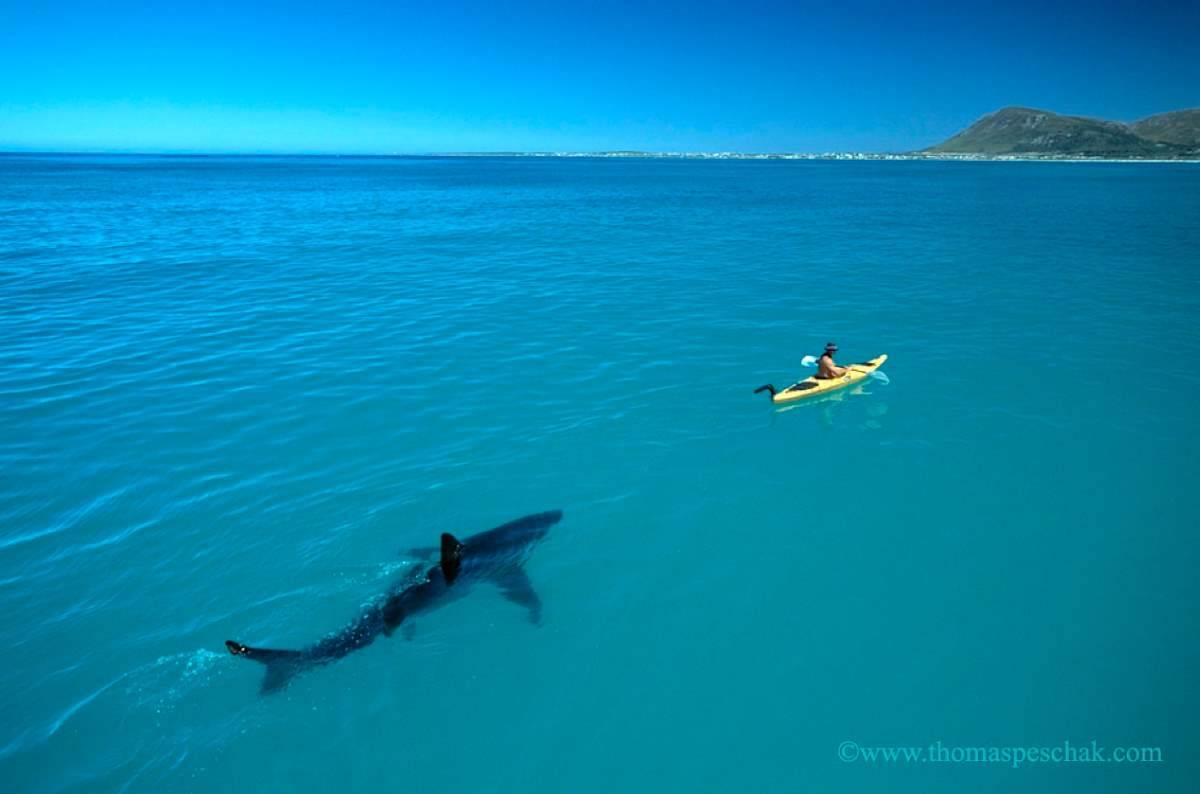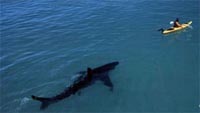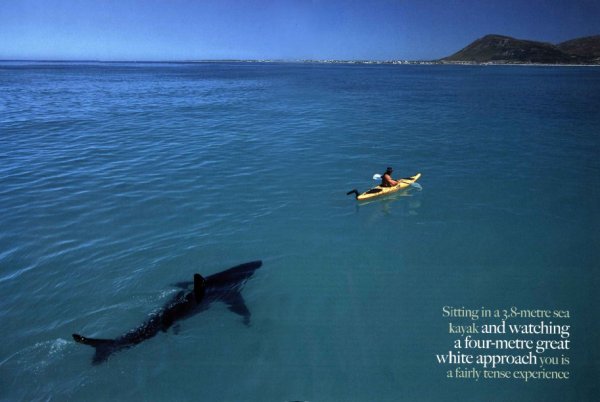Sharks and Sea Kayaks

 A while ago we were sent the “Great White Following Sea Kayak” photo by someone who asked where it was taken and whether it was indeed genuine. Surfski.info published it and a lively debate resulted with the consensus of opinion being that the photo was a fake.
A while ago we were sent the “Great White Following Sea Kayak” photo by someone who asked where it was taken and whether it was indeed genuine. Surfski.info published it and a lively debate resulted with the consensus of opinion being that the photo was a fake.
It’s not a fake. After unsuccessfully trying to find the photo on the Internet, I resorted to sending emails to shark tourism companies and one of them finally pointed me at the photographer who took the shot...

The photo was originally published in Africa Geographic magazine in September 2005 in an article entitled, “Shark Detectives” by Thomas P. Peschak and Michael C. Scholl, which may be read online at the Africa Geographic website. There’s a R50 (approx. $8) charge for access to the article archives – well worth it in my opinion. The photo is also available in poster form and may be purchased on the website. Click here to reach the article.
Michael Scholl is a marine biologist who has been conducting research into Great White sharks with Thomas Peschak since 1997. Part of the research has been into the behaviour of Great Whites in Shark Bay, near Gansbaai, and this was where the two men resorted to watching the sharks from sea kayaks in order to follow them into shallow water out of reach of the research vessel.
The full story can of course be read in the online article, but bare facts are as follows:
- Large numbers of Great Whites appear in Shark Bay annually between September and mid-January, frequently venturing into water as shallow as 2m.
- When they do this they are not hunting; they ignore bait slicks (and bathers), swimming through them without any reaction – in contrast to their behaviour at other locations such as Dyer Island.
- In order to observe the sharks in shallow water, the two men had to find a means of following them there – and chose sea kayaks.
- This method of observation is only part of the research – other platforms used include aircraft and cameras mounted on tethered balloons.
The level of protection offered by a sea kayak is minimal to say the least – so the sharks were first tested with an empty kayak. The only reaction was minor curiosity (or to spell it out, the sharks would circle the kayak and look at it, but they never tested it with their teeth).
Michael is quite happy now to paddle with the sharks especially as the sea kayaks seem a minimally invasive platform from which to do so. Individual sharks sometimes circle the kayak, and will occasionally lift their heads out of the water to take a better look, but subsequently ignore the kayak altogether allowing the researcher to follow closely behind.
When asked what a paddler should do if a shark is sighted, Michael said, “First and foremost, enjoy the moment!” This is a rare interaction with nature and one that is unlikely to have unpleasant consequences. “Sharks that you see are rarely the problem,” he added, “but the one thing you must not do is panic!”
He recommends that you stop and sit quietly as the splashing of the paddle in the water could attract the attention of the shark. “They’re very curious,” he said, “but also extremely cautious.” If the shark seems to show too much interest in your craft, he recommends that you “push the shark away gently on the nose with the tip of the paddle. In most cases the shark will lose interest and will swim away.”
And if you’re unfortunate enough to be in the water? He chuckled as he said, “make yourself as small as possible! Don’t dangle arms or legs, keep them close to your sides or hug the ski. Above all don’t panic and don’t thrash around.” And don’t try to swim away as, just with other wild animals, this stimulates aggression. “As a last resort, swim towards the shark, not away from it.”
Has he been back kayaking with the sharks? Not this year - partly because the sharks were not as numerous, but the weather was the main problem. And would he take anyone with him? “Sure,” he said, “call me in September!” Hmm…

